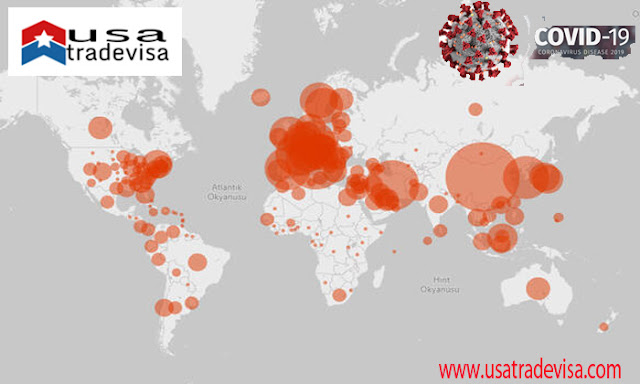Fossil discoveries show that epidemics have existed since hunter-gathering communities, but epidemics have shown their real impact after the formation of the first urban states, with the agricultural revolution and the transition to settled life.
The first epidemic in the written sources indicates about 2500 years ago. Diseases spread worldwide are defined by the World Health Organization as a pandemic. What is the Meaning of the Word of Pandemic ?: The pandemic, consisting of the Greek origin, a combination of the words pan (all) demos (folk), expresses outbreaks that will affect all humanity.
Pandemic Cases in World History
Fossil discoveries show that epidemics have existed since hunter-gathering communities, but epidemics have shown their real impact after the formation of the first urban states, with the agricultural revolution and the transition to settled life.The first epidemic in the written sources indicates about 2500 years ago. Diseases spread worldwide are defined by the World Health Organization as a pandemic. What is the Meaning of the Word of Pandemic ?: The pandemic, consisting of the Greek origin, a combination of the words pan (all) demos (folk), expresses outbreaks that will affect all humanity.
Pandemic history - Chronological Pandemic
B.C. 430 Peloponnesian war plague:The first pandemic in recorded history was described by the Athenian historian and commander Thucydides. M. Ö. In 430, during the Peloponnesian War between Athens and Sparta, Thucydides speaks of an outbreak (though to be typhus or Bubonic plague) that killed more than 30,000 Athenians. Those who died in this epidemic were included in the history of Athens in terms of indicating a ratio between 3/1 and 3/2 of the Athens population.
A.C. 165 Antonin Plague (Antonine Plague)
In 165 AD, the famous Greek medicine man Galen identified a pandemic, which was thought to have been brought to Rome by soldiers returning from Mesopotamia, when he served on behalf of the emperor in the Roman capital. This epidemic was killing about 5000 people a day in Rome, one of the largest cities of that period, during its most violent periods.
The disease spread to all cities in the Mediterranean basin, all ancient cities in Italy, Spain, the Aegean basin, and ancient cities in North Africa, especially Egypt. It was affected by the outbreak, including the Roman cities in France and even England.
Periodic inscriptions from Roman historians show that the disease lasted for about 15 years with ups and downs, and an estimated 5 million Romans died in this process due to epidemics. The disease, 2 Roman emperors died in the process due to this disease. The disease was named after one of the deceased emperors, Marcus Aurelius Antoninus.
A.C. 250 A.D. Cyprus Plague (Cyprian Plague)
The plague named after Saint Cyprian, Carthage bishop, probably started in Ethiopia, from North Africa to Rome, then Egypt.
Over the next three centuries, recurrent outbreaks occurred as regional outbreaks. Outbreak M.S. It hit Britain in 444.
The bishop described the disease in a terrible, but completely specific, a written record called "De mortalities". Accordingly, the outbreak symptoms; diarrhea, vomiting, throat ulcer, fever, gangrenous hands, and feet. Translated from Latin in 1885 by Philip Schaff, the record described the psychopath outbreak as the end of the world.
A.C. 541-542 Justinian Plague: (Justinian Plague)
A major epidemic in the capital of the Byzantine Empire in 541-542 AD was named the Justinian Plague in the name of Emperor Justinianus I, who ruled that period. In Constantinople, it is said that about 10,000 people die per day. At the end of the epidemic, half of the city population died. Historians say that those who died in this outbreak amounted to a quarter of the human population in the Eastern Mediterranean.
It was believed that the Justinian plague began the city of Constantinople, where the disease was most effective, through merchant ships from Egypt. Plague bacteria (Yersinia pestis) included in the Justinian pandemic was found in the DNA of a Hun individual found in the Tian Shan mountains of Central Asia and found to have died around 200 AD. This Tian Shan strain is more "basal" than the Justinian form of plague, meaning it goes further back in the plague's genetic "pedigree". Therefore, it is believed that the plague of Justinian reached Byzantine through the Silk Road network established with China or Hun migrations to the Byzantine end cities or the attacks of the raiders.
A.C. 1200 Chinese Scarcity and Diseases
In 1200 AD there are sources that the population of China is more than 120 million. However, this population dropped to 65 million after 200 years. Written sources about a famine that lasts for years indicate that people died in communities due to famine. It is difficult to make a determination after 800 years, but it is highly probable that the disease accompanied by famine is a plague.
The 1340 Plague Outbreak - Black Death:
After the Justinian Plague in 541-542, the plague goes to the historical scene with minor, regional epidemics, but the plague epidemic between 1347-1351 caused the death of 75 million people in Asia and Europe.
Although the plague called black death is seen in all the colonies on the Black Sea coast, in Anatolia, Syria, and Egypt, the most effective place was the European continent, and an estimated half of the European population died.
It was called prickly, pneumonic, in the most common form that gave the name to the disease called black death. Bubbles that turn into the black form on the skin of people with bubonic plague, because the skin begins to rot while the person is still alive.
1492: The Columbian Exchange Native Americans Chickenpox Disease
Chickenpox is a disease that has affected 3/1 of the European population throughout the medieval period, but the people of the old world developed immunity to this disease over time. When Hernan Cortez landed in Mexico, an estimated smallpox disease led to the death of 15 million Aztecs.
Following the Spanish arrival in the Caribbean, diseases such as smallpox, measles, and bubonic plague were transmitted to the indigenous peoples by Europeans.
When Christopher Columbus arrived on the island of Hispaniola, the local people of the area had a population of around 60,000. In 1548, the island population was less than 500 people. Many such figures show a terrible population of slaughter as a result of illnesses without being exposed to conflict.
In 1520, the Aztec Empire was defeated by the Spaniards in the Otumba war, but smallpox brought on by African slaves was the main force that broke the Aztec army. 90% of the indigenous population living in the American continent during the war and ongoing years died due to various diseases transmitted from the Europeans, the immune systems of the American natives against these diseases were completely vulnerable. For this reason, colonizing the American continent has been very easy.
Research in 2019 reveals that about 56 million Native Americans died in the 16th and 17th centuries, largely due to European and African diseases, the cultivation of cultivated agricultural lands, vegetation growth, which has been cultivated for hundreds of years before to feed millions of people. concluded that the Earth may have changed the climate because it draws more CO2 from the atmosphere and causes a cooling event that will affect the continent.
Syphilis - Syphilis 1500 - 1520
Between 1500 and 1520, about 10 million Europeans died due to more lethal syphilis, that is, syphilis.
1700s Flu Outbreaks:
In the years 1729-1730, 1732-1733, 1781-1782, Influenza pandemics of various sizes occurred in various parts of the world, especially in Europe.
1793, Yellow fever
He killed 15% of the city population due to an epidemic in the US / Philadelphia city.
The flu pandemic that started in 1830: 1781 in China spread from Asia to Russia, and the mortality rates in this epidemic that caused high mortality among the elderly are not clear.
Cholera Pandemics in 1817 and After (cholera plagues);
In the 19th century, Cholera became the world's first truly global disease in a series of epidemics, at this time when modern cities began to form.
If we list the important Cholera outbreaks:
- First Cholera epidemic: 1817-1823, 1 million people died in Russia
- Second Cholera epidemic: 1829-1851,
- Third Cholera epidemic: 1852-1859,
- Fourth Cholera epidemic: 1863-1879,
- Fifth Cholera epidemic: 1881-1896,
- Sixth Cholera epidemic: 1899-1923:
- Seventh Cholera epidemic: 1961 - 1970
- Eighth Cholera epidemic: It can be dated from 1991 to the present.
- Of the 30,000 infected in Egypt in 1947, 20,500 died.
1918-1920 Spanish Flu (Spanish flu)
In the last months of World War I, a deadly flu virus was detected in a military camp in the USA / Kansas. Within 6 months, the flu had become a worldwide pandemic. During the First World War, 6.6 million civilians and 10 million soldiers died, and the Spanish flu that started immediately after the war that lasted 4 years passed on to half of the world's population, approximately 1 billion people.
More than 25 million victims died in the first six months of the outbreak. Although the number of dead is not clear, it is believed to be between 50 and 100 million.
The influenza strains that cause pandemic are divided into subtypes by looking at the antigenic structures of hemagglutinin (H) and neuraminidase (N) glycoproteins on the virus surface.
The flu virus was seen in humans before 1889 had the H1 antigen. But in 1889, a new type of H2 flu appeared in Russia and spread to the world. H2 killed about 1 million people, but for about 30 years, it caused people who had flu for the first time to develop anchors against the h2 antigen, that is, build their immunity accordingly.
The Spanish flu antigens that started in 1918 were H1N1, that is, those born in 1889 were immune to H1, that is, the Spanish flu was not effective in the population over the age of 40. On the other hand, there was no serious flu outbreak since about 1900, and the metabolism of people aged 0-20 years who first met the flu microbe created strong antibodies for the H1 antigen, meaning that people between the ages of 0-29 were not severely affected by this flu.
Unfortunately, the victims of the Spanish Flu, H1N1, were between the ages of 20 and 40, who were unable to develop immunity to this new virus, as they had previously met the H2 virus. The mass, which is thought to be the strongest and healthiest age group in the society, made up a large part of the loss.
Treatment opportunities and drug abstinence in the outbreak caused various quarantine and isolation measures to be taken. Especially in cities, people were ordered to wear masks, schools, factories, shops, and entertainment venues were closed, people were asked not to get close to each other, to leave their homes unless obliged, but the measures were only preventive. The reason for the end of the epidemic is shown as the mutation of the virus over 2 years.
What is the Reason for Calling Spanish Flu: The virus called "Spanish Flu" or "Spanish Lady" was called Spanish flu in the Ottoman Empire.
In fact, the virus did not start in Spain, but due to the First World War, reporting on epidemics was prohibited in all European and US media, as it would reduce the moral motivation of the public, so virus news was first included in the Spanish media that did not participate in the war.
The Spanish people called the flu as the French flu because in reality the virus was transmitted to Spain by the French, but the whole world named the disease as Spanish flu, as it was the first time the virus was heard.
Russia famine and typhus outbreak in 1917-1921
In the First World War, Russia gave the real loss not through the battlefield, but with famine and epidemic diseases. As a direct consequence of famine and various diseases, 10 million Russians died. At least 3 million people died from typhus.
1947 Malaria Epidemic in India (Epidemic in India)
About 1 million Indians died as a result of the biggest malaria epidemic in the history of the world, during the chaos of independence struggles that India got rid of the British colony.
As late as 1940, just before the clever spread of antibiotics, about 13,000 Americans were still dying from syphilis every year.
1957 Asian Flu - Asian Flu (1957 Influenza Pandemic)
An H2N2 virus has completely replaced the H1N1 viruses that have been circulating in humans since 1918, causing an “Asian” flu pandemic. This Pandemic killed 1-1.5 million people worldwide.
The virus is produced by a reassessment, replacing human-adapted H1N1 genes with H2N2 avian influenza. New H and N surface proteins mean that most people don't have antibodies to the virus, which causes pandemics. However, its adapted genes mean it's not as deadly to humans as the 1918 virus, which comes with a few changes from birds.
People tend to mount the best immune response to the first flu virus they experience. Therefore, people born before 1957, whose first flu experience was later circulating H1N1 viruses, have some immunity against the 2009 H1N1 strain causing the current pandemic. People born after the pandemic of 1957 do not have this immunity.
1968 Hong Kong flu - HongKong Flue Pandemic (H3N2 virus)
Influenza H3N2 virus was caused by the influenza outbreak in 1968. Although relatively non-fatal, the virus was highly contagious as it spread to Southeast Asia two weeks after its first appearance in Hong Kong in July 1968. In December, the virus reached the United States, Britain, and other countries in Europe. He killed an estimated one million people.
The virus differs only from H2N2 in one of its surface proteins, H; Since many people still have antibodies to the N2 protein that does not change, their effects are less severe. But since H3N2 completely replaces H2N2 in humans, nobody born since 1968 has any immunity to H2.
1981-2011 (and ongoing) AIDS:
Acquired Immune deficiency syndrome (AIDS) has killed more than 25 million people since it was first recognized in 1981, making it one of the most devastating outbreaks in recorded history.
To date, the HIV virus has infected more than 65 million people. The treatment has still not been developed for this sexually transmitted disease. Current treatment methods and medications are only treatment methods that keep the virus under control and allow people to live longer.
2002-2004 SARS
SARS (Severe Acute Respiratory Syndrome) appeared in Guangdong, China in February 2003. A few months later, cases diagnosed with SARS appeared in North America, South America, Europe, and Asia. There were around eight thousand cases and 774 deaths worldwide. The disease was manifested by high fever, body aches, and dry cough symptoms.
The main treatment in SARS was supportive therapy for emerging respiratory problems. Since the symptoms of the disease developed suddenly and severely, it was easy to detect, so it was easy to prevent the spread of measures, but the disease disappeared by mutation before a clear treatment could be developed. There were no SARS cases after 2004.
2019 Covid-19 Coronavirus
What is coronavirus? : Covid-19 Medical Description: Coronavirus (COV) is considered to be included in the virus family, but Coronavirus is a general term and includes other viruses detected in the past years, including Middle East Respiratory Syndrome (MERS - CoV) and Severe Acute Respiratory Syndrome (SARS-CoV). (source: www.ihracat.co)
What are Covid-19 Disease Symptoms? : Coronavirus's most common symptoms occur with symptoms such as fever, dry cough, breathing difficulties. There are patients with symptoms such as nausea, vomiting, diarrhea.
How Covid-19 Is Transmitted: Coronavirus is thought to be infected as a result of the contact of infected people with cough, sneezing through the viral way, or by touching the mouth, nose, or eyes of the people who intervene with the hands, to the hands of the people who have interfered with it. It is also claimed to be caused by the penetration of the virus. Its ability to spread so easily makes the virus extremely infectious.
What is the Coronavirus Incubation Period? : The general opinion about Covid-19 virus incubation period is between 2-14 days. However, many scientists state that infected patients can be carriers for up to 21 days and must be isolated by this time.
What is Coronavirus Infection Rate ?: Being transmitted virally, it allows the disease to be transmitted to all individuals in a population that it populates if measures are not taken. He predicts around 1-2% for the death rate caused by the virus.
The virus can be transmitted to people who have survived the disease.
What is Super Carrier ?: Some patients can spread the virus as healthy looking carriers without any symptoms. There is no criterion for being a supercarrier, people who can cough up the immune system coronavirus without causing any symptoms. In the Covid-19 process, it is envisaged that especially children aged 8 and under could join this class.
The virus, which has reached 3.8 million cases and more than 265 million deaths as of May 2020, is spreading rapidly worldwide. Experts predict that 60% of the world's population will be transmitted to 80%. Millions of people are likely to die if an effective drug and vaccine cannot be developed. We can say that Covid-19 is the biggest and most destructive pandemic that emerged after the Spanish Flu.






















COMMENTS